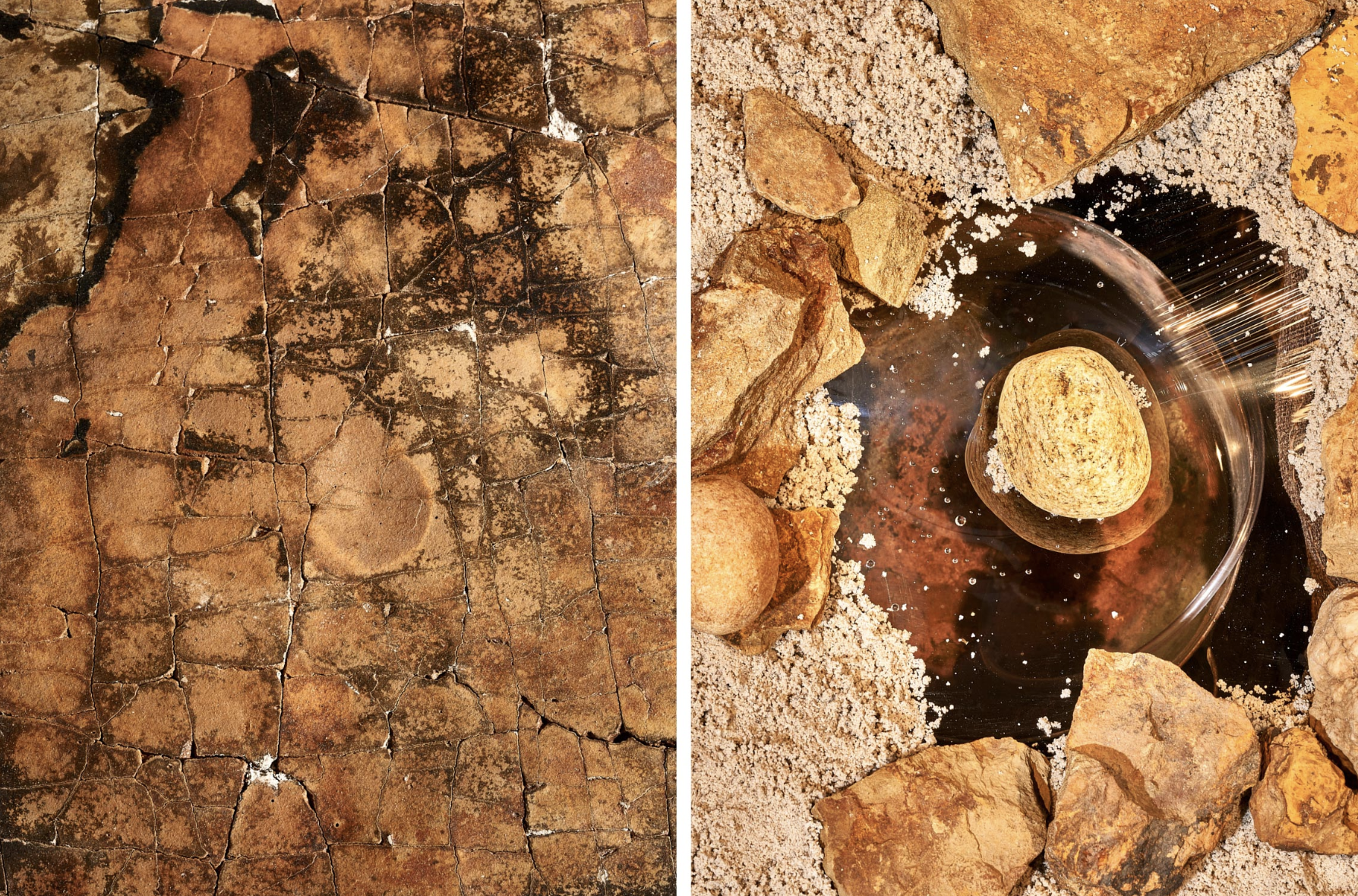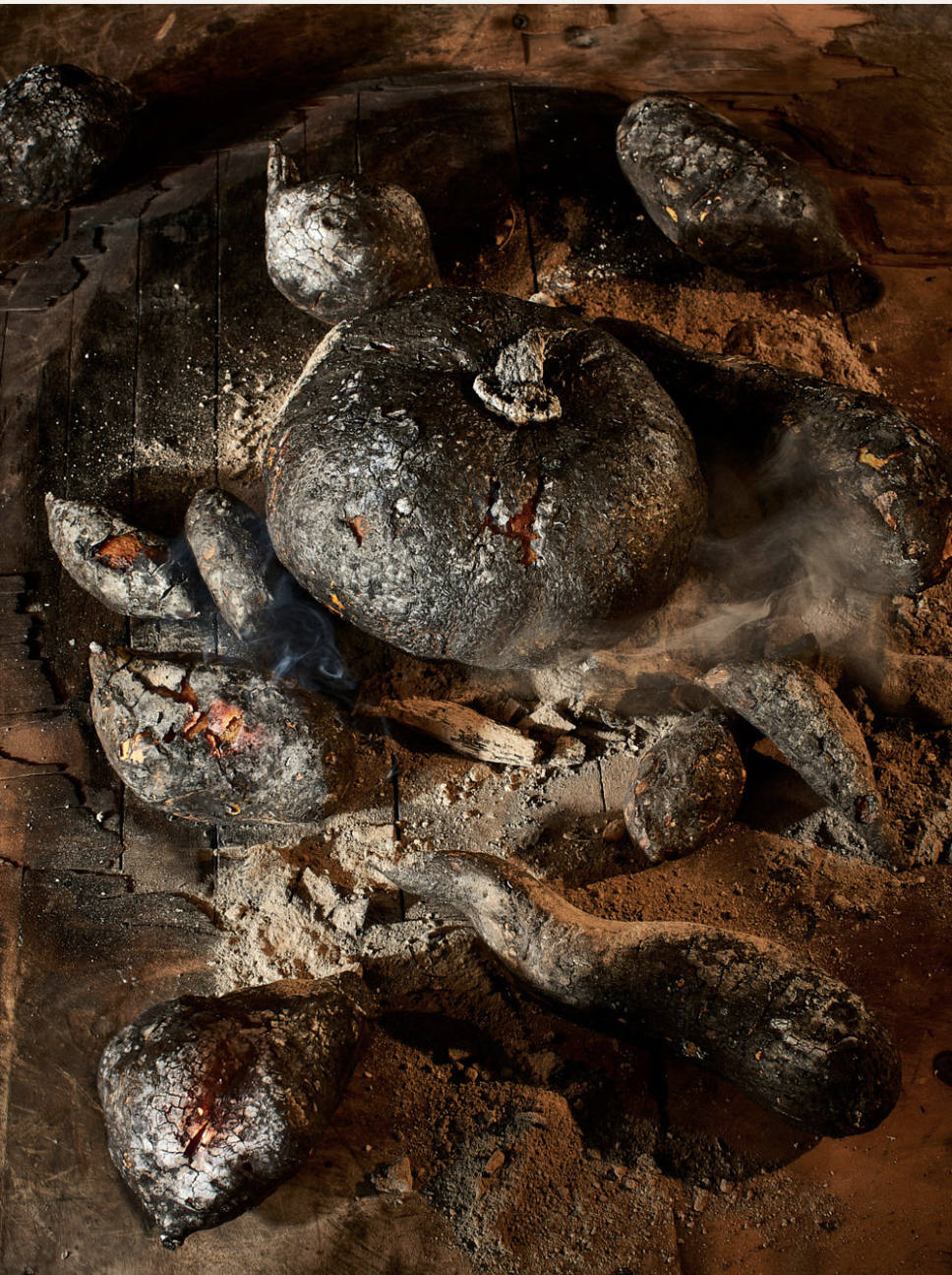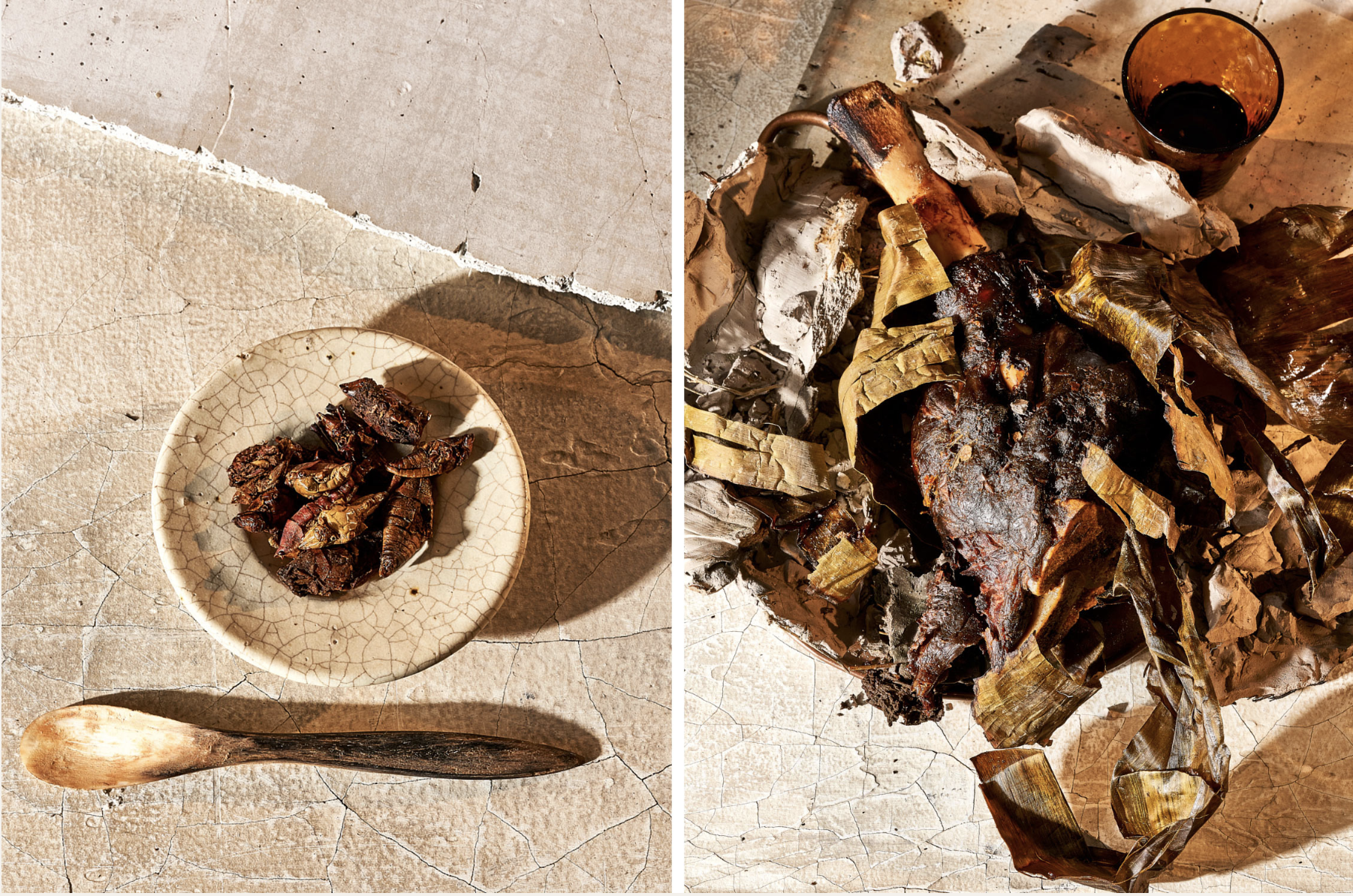

Speculative images and foodscapes in response to climate-fueled drought + wildfires.
We utilize the potential for food as an affective, embodied, and intimate medium to unspool future ecological realities through recipes. Ash-cooked root vegetables speak to the presence of increased wildfires and the need for hearty crops that can withstand environmental distress; pomegranate wine reflects the need for drought-tolerant ingredients in the beverage industry; buckwheat and sorghum bread reveal a critique of the monocropping of wheat and the perilous future it activates for both humans and non. The recipes and foods in this series speak to the vitality of edibles as (non-human) bodies that become ‘quasi-agents’ and ‘forces with trajectories, propensities or tendencies of their own,’ as Jane Bennett describes in her writing on materiality. By engaging with foods that are imperative to our ability to adapt to the desertification of arid farming regions in a warmer climate, we must accept the many mutual transformations we will engage with over the next 50 years. Bennett emphasizes that ‘eating constitutes a series of mutual transformations between human and nonhuman materials,’ and ‘edibles disclose, in short, what Deleuze and Guattari called a certain “vagabond” quality to materiality, a propensity for continuous variation. The aesthetics of food are about ecological relations; eating links us to the entangled realities of environments and nonhumans through our sensory encounter with it (Higgins 2002). Taste is a “sensate form of knowledge” (Higgins 2002) through which we “participate directly in the world” (Dewey 1934). The importance of this aesthetic and sensory experience has ecological implications: food acts as a meaningful site through which to acquire knowledge about the world—a person is, in fact, processing the environment with her body when she eats (Wist 2021).
Collaborative photo essay with Heami Lee (photographer); Rebecca Bartoshesky (props); and Victoria Granof (food stylist & recipe developer).
Recipes:
Aperitif of extracted desert water
Mealworm toffee
Ash-cooked ground provisions
Cactus casserole (ala green bean casserole)
Cactus fruit leather
Cricket flour crackers (w. flour from Seek Foods)
Root vegetable hummus topped with crumbled grasshoppers
Clay-caked goat
Toasted sorghum "coffee"
Buckwheat Kvass and Pomegranate Wine
Dried plants and fungi
Ingredient & food systems research below




Parched earth lay ahead, and our attention shifts to acceptance, to adaptation. Our food system must radically endeavor to meet the complete re-mapping of our earth as it grows hotter and direr in the American Southwest, Africa, India, and large swaths of Latin America. We are all in a drought; we are withholding ourselves, baited breath as we watch California burn. Fields and fields and fields of almonds.
The time has come for an unveiling of the disaster. We find what has always been there—ingredients that drifted out of use, cooking methods and preservation techniques that we thought we no longer needed. How much from our past, from alternative ecologies, from new states of mind, might we be able to uncover to feed ourselves in a time of lack?
This project is a dystopic ficto-critical look at foods that will be viable in newly rendered inhospitable aird areas, and foods that speak to a more resilient food system.
The ingredients, recipes, and concepts are the result of a two-year body of research into the future of our food system, including interviews with climate scientists at MIT, on-site research in Israel, Hawaii, and Colombia, and inspiration from scholars, scientists, and farmers around the world. We aimed to visualize current and near-future adaptations to climate change, specifically looking at issues of desertification and drought as substantial contributors to how we will eat in the future. It presents a sensory ethnography for understanding new places now arid.
Underneath the ochre sand, we can find water. We turn to landscapes and farms, to ground provisions and einkorn wheat. It is a time to cherish every strange odor, every pungent taste.

CACTUS
Cactus has been identified as a promising future food
source, and the Food and Agriculture Organization
of the United Nations has explicitly encouraged
cultivation of prickly pear cactus as a crop in countries
ranging from Ethiopia to Madagascar to the US.
(It has long been a culinary ingredient in both its
native Mexico and in Italy.) Cactus pear is able to grow
on land where no other crops are able to grow, and
requires very little water, producing both edible cactus
meat (or “nopales”) and sweet cactus fruit. The challenge
to using cactus in places like American and Europe
will be in contextualization, as using this ingredient
outside its cultural context can threaten to adversely
impact the communities of origin.
SORGHUM + BUCKWHEAT
Reliance on just a few mono-crops makes our entire
food system vulnerable—corn, soy, and wheat may
not stand up against harsher temperatures and
more extreme weather. For a more resilient food
system, we will need to cultivate alternatives to our
current staple crops. Both sorghum and buckwheat
have been suggested as hearty future staple crops.
MUSHROOMS
Scientists have highlighted fungi as a way to
reduce the amount of greenhouse gasses emitted
from soil. Mushrooms could be powerful allies in
detoxifying our environment and sustaining robust
soil microbiomes on farms.
GROUND PROVISIONS
Root vegetables like squash, sweet potatoes, and
beets require less water than other vegetables and
are recommended for home gardeners dealing
with drought climates or water shortages.
INSECTS
Global protein consumption could hit a crisis
point—we are eating too much meat, and countries
around the world are increasing meat consumption.
Insects could provide more protein to more people
with substantially less environmental impact than
other types of meat. They are amazingly efficient
at converting energy into protein and farming them
uses less water and land. Insects are also rich in
vitamins, healthy fats, and amino acids. Robust
culinary traditions around insect-eating already
exist in a variety of cultures around the world—
almost 2 billion people consume insects already
from Mexico to Southeast Asia to Japan.
JERKIES + DRIED GOODS
In contemplating landscapes made more arid and
dry, jerkies and dried products immediately come
to mind. They are often dried out in the sun and in
hot temperatures, making them a natural fit for a
drier climate.
POMEGRANATE WINE + BUCKWHEAT KVASS
Pomegranates are drought-tolerant fruits that can
be used to make both wine and port, the latter of
which is aged outside in the blazing sun for up to 6
months. Kvass is a buckwheat-based alternative to
beer—in recent research published in the journal
Nature Plants, scientists suggest that beer will
be threatened by climate change due to reduced
barley production caused by extreme weather.
Buckwheat, and other alternative grains, will be
important to diversifying our future food system
and reducing our reliance on wheat.
GOAT
As part of a regenerative agriculture system, goats
can provide an important ecological benefit over
cows or pigs. They are “browsers” as opposed to
grazers, reducing their damage to the environment
and to ecosystems. In areas prone to wildfires,
goats have also been suggested as a way to reduce
flammable brush.
